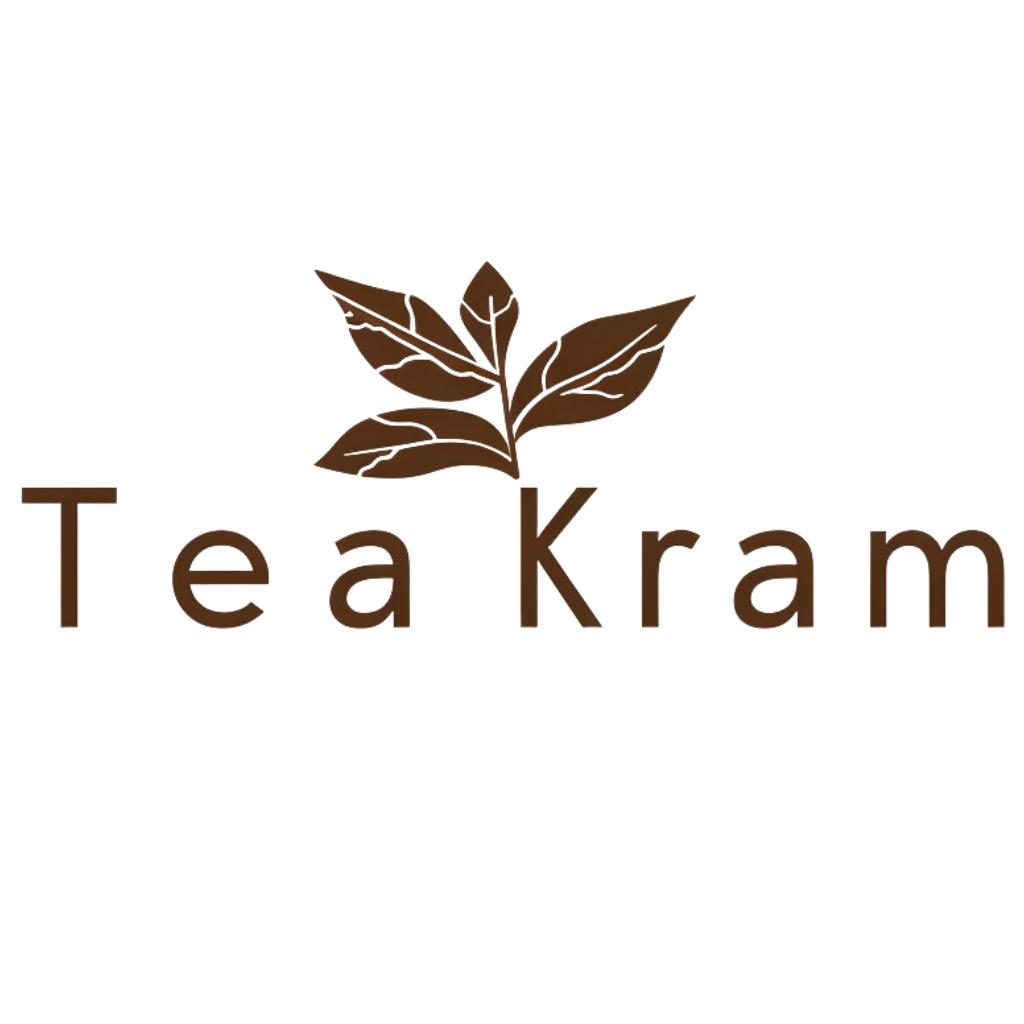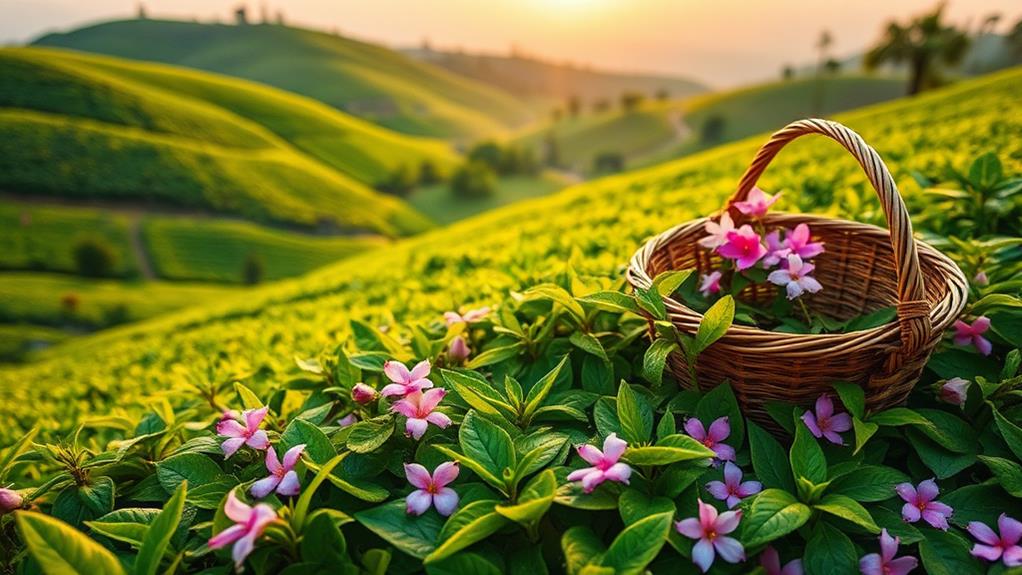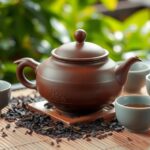Darjeeling tea, often called the "champagne of teas," comes from the Himalayan region of India and has a rich history dating back to the 19th century. You're likely to encounter various types, including First Flush, Second Flush, and Autumnal, each with its own distinct flavor profile. This tea is known for its enchanting floral notes and muscatel hints, making every sip a unique experience. Plus, it offers health benefits, like antioxidants that boost your well-being. As you explore, you'll discover the best brew techniques and pairings, ensuring an enjoyable tea time that you won't want to miss!
History of Darjeeling Tea
Nestled in the foothills of the Himalayas, the history of Darjeeling tea dates back to the early 19th century. It all began when British colonists discovered the region's ideal climate and rich soil, perfect for cultivating high-quality tea. You mightn't realize it, but the first tea saplings were brought from China, sparking a journey that would change the world of tea forever.
By the 1850s, Darjeeling tea was gaining popularity, and its unique flavor quickly caught the attention of tea enthusiasts. You can imagine the excitement as the first batches were shipped to England, where they created a buzz among tea drinkers.
This innovative spirit didn't stop there; local farmers began experimenting with different cultivation techniques, enhancing the tea's distinct floral notes and muscatel flavors.
As demand soared, tea estates sprang up, each adding their own twist to the brewing process. The tea's rich history is woven with tales of resilience and creativity, showcasing how a simple leaf can unite cultures around the world.
Types of Darjeeling Tea
Darjeeling tea comes in several distinct types, each offering a unique flavor profile and aroma. You might be surprised to learn that these types stem from the time of harvest and the specific processing methods used. The main categories include first flush, second flush, and autumnal teas.
First flush teas are harvested in the spring and are known for their light, floral notes. They're fresh and vibrant, capturing the essence of new growth.
Second flush teas, picked in the summer, boast a richer, more robust flavor with muscatel notes that many tea lovers crave. They often have a deep amber color that's just inviting you to take a sip.
Finally, autumnal teas come from the fall harvest, bringing a more mellow and full-bodied taste, perfect for cozy evenings.
Each type of Darjeeling tea tells a story of its season and environment, inviting you to explore its variety.
Cultivation Process
When you explore the cultivation process of tea, you'll find that the unique climate and geography of the Darjeeling region play an essential role in producing high-quality leaves. Nestled in the Himalayas, this area boasts cool temperatures, abundant rainfall, and rich soil—perfect conditions for growing tea.
As you dive deeper, you'll see that tea bushes thrive at high altitudes, where the misty mornings and sunny afternoons create the ideal environment for flavor development.
Innovative farmers often use traditional techniques alongside modern practices, ensuring sustainability and quality. You'll notice that they hand-pick the tender leaves during the first flush in spring, capturing the freshest flavors. This labor-intensive process showcases their commitment to excellence.
Moreover, many growers are experimenting with organic farming methods, reducing chemical inputs while enhancing the natural flavors of the tea.
As you learn about the cultivation process, you'll appreciate the meticulous care and passion that go into each leaf. It's not just about growing tea; it's about creating a product that tells a story of the land and the people who nurture it.
Flavor Profile
When it comes to Darjeeling tea, the flavor profile is truly a delightful experience.
You'll notice its unique aroma and fragrance notes, which can range from floral to fruity, making each sip a sensory adventure.
Plus, the way you brew it can really impact the taste, so let's explore how to reveal the best flavors from this exquisite tea!
Aroma and Fragrance Notes
The enchanting aroma of Darjeeling tea captivates the senses with its delicate complexity. As you steep those fragrant leaves, prepare to be whisked away on a sensory adventure.
You'll notice the bright, floral notes that greet you first, reminiscent of blooming orchids and fresh blossoms. This is no ordinary tea; it's a fragrant masterpiece waiting to unfold.
As you inhale deeper, hints of muscatel emerge, adding a sweet, fruity undertone that's both invigorating and intriguing. Think of ripe grapes kissed by the sun.
There's also a gentle earthiness that grounds the experience, bringing to mind the lush, mountainous landscapes of the Darjeeling region.
Diving into this aromatic profile, you might even detect subtle whispers of spice, perhaps a touch of cinnamon or cardamom, enhancing the overall bouquet.
The interplay of these fragrances creates a symphony that invites you to savor each moment.
Taste Characteristics Overview
Sipping Darjeeling tea reveals a flavor profile that's as complex as its aroma. You'll notice a delightful balance of floral notes and a hint of muscatel, making each sip feel like a journey through a garden. The first taste might surprise you with its lightness, but as it unfolds, deeper flavors of stone fruits and a whisper of nuttiness emerge. This unique blend creates a revitalizing experience, unlike any other tea.
Here's a quick overview of what you might taste:
| Flavor Notes | Description |
|---|---|
| Floral | Delicate hints of jasmine or rose |
| Fruity | Notes of peach and apricot |
| Earthy/Nutty | Subtle undertones of almonds |
You'll appreciate how these flavors dance together, revealing the tea's craftsmanship. The finish is crisp and clean, encouraging you to take another sip. Whether you're a seasoned tea lover or a curious newcomer, Darjeeling tea promises something special. So, grab your cup, and let your taste buds explore the exquisite complexity that this tea offers!
Brewing Impact on Flavor
Brewing Darjeeling tea can considerably influence its flavor profile, bringing out different nuances with each method. You might be surprised how a simple change in brewing time or temperature can lead to a whole new experience.
For example, if you steep Darjeeling leaves for just two to three minutes at around 85°C (185°F), you'll often taste floral and fruity notes. But extend that time to four or five minutes, and the tea's more robust flavors emerge, providing a deeper, more complex taste.
Using water with the right mineral balance can greatly enhance the tea's complexity, as minerals interact with the tea compounds to shape the overall flavor experience optimal tea brewing.
Experimenting with water quality is another way to innovate your brewing technique. Using filtered water can enhance the tea's natural sweetness, while hard water might overshadow its delicate flavors. Additionally, consider the tea-to-water ratio; a little extra tea can intensify the flavor, making your cup more vibrant and exciting.
Don't shy away from trying different brewing methods, either! From traditional teapots to modern infusers, each tool can yield a unique outcome.
Health Benefits
When you sip on Darjeeling tea, you're not just enjoying its unique flavor; you're also treating your body to some great health benefits.
This delightful brew is packed with antioxidants, which help fight off harmful free radicals, and it can support your heart health too.
Additionally, Darjeeling tea contains flavonoids that may help lower blood pressure and improve heart function, making it a heart-friendly choice.
Plus, if you're looking to manage your weight, incorporating this tea into your routine might just be a smart move, as it can enhance metabolism and support digestion aiding weight loss and digestion!
Antioxidant Properties Explained
Darjeeling tea is renowned not just for its unique flavor but also for its impressive antioxidant properties. These antioxidants, mainly polyphenols, play an essential role in protecting your body from free radicals—those pesky molecules that can cause cell damage. When you sip on a cup of Darjeeling, you're not just enjoying a delightful beverage; you're arming your body with powerful compounds that help fight oxidative stress.
Regular tea consumption can act as a protective shield against daily stressors and harmful free radicals, making Darjeeling tea an excellent addition to your wellness routine health benefits of tea.
Research shows that these antioxidants can support your overall well-being. They may help reduce inflammation, boost your immune system, and even promote healthier skin. Imagine sipping a cup of tea that not only warms you up but also works hard behind the scenes to keep you feeling vibrant!
What's exciting is that the unique growing conditions in Darjeeling, like its high altitude and specific climate, produce tea leaves rich in these beneficial compounds. So, every time you enjoy a cup, you're tapping into nature's innovation.
Heart Health Benefits
Enjoying a cup of Darjeeling tea can be a delicious way to support your heart health. This exquisite tea isn't just a treat for your taste buds; it also packs a punch when it comes to heart-friendly benefits.
Rich in antioxidants, Darjeeling tea helps combat oxidative stress, which can lead to heart problems. By sipping this fragrant brew, you're actively working to reduce inflammation and promote better blood circulation. Incorporating tea rituals into your daily routine can also foster a deeper sense of mindfulness and tranquility, enhancing the overall experience of enjoying tea mindfulness and presence.
Moreover, the flavonoids found in Darjeeling tea can help lower cholesterol levels. When you enjoy a cup, you're not just indulging in a delightful experience; you're also helping to keep your heart in tip-top shape.
Studies suggest that regular consumption of such teas can lead to lower risks of heart disease, making it a smart choice for your daily routine.
And let's not forget the calming ritual of brewing and savoring tea! Taking a moment for yourself to enjoy Darjeeling can reduce stress, another key factor in heart health.
Weight Management Support
For those looking to manage their weight, incorporating Darjeeling tea into your daily routine can be a smart choice. This delightful beverage isn't just about its exquisite flavor; it's also packed with health benefits that can support your weight management goals.
The unique antioxidants found in Darjeeling tea, called polyphenols, help boost your metabolism, contributing to better overall wellness and longevity. This means your body burns calories more efficiently, which is essential for weight control. Additionally, sipping on Darjeeling tea can help curb your appetite. When you drink it, you may find yourself feeling full and satisfied, reducing the temptation to snack mindlessly throughout the day.
Plus, its natural caffeine content provides a gentle energy boost, perfect for those workout sessions you've been planning.
Moreover, the exceptional health benefits of tea, including Darjeeling, further enhance its role in a balanced lifestyle.
What's more, Darjeeling tea's soothing properties can help manage stress, which often leads to emotional eating. By creating a moment of calm in your day, this tea encourages mindful eating habits.
Brewing Techniques
When it comes to brewing Darjeeling tea, precision is key to revealing its delicate flavors and aromas. Start by using fresh, filtered water, as this will greatly enhance your tea experience.
Heat the water to about 185°F (85°C) — boiling it will scorch the leaves and ruin the subtle notes.
Next, measure out about one teaspoon of loose leaf tea per cup. Darjeeling tea is all about balance, so don't overdo it!
Once your water's ready, pour it over the tea leaves and let them steep for 3 to 5 minutes. Remember, patience is important here; if you steep too long, you risk bitterness.
For a fun twist, consider experimenting with multiple infusions. You can steep the same leaves again and discover new flavors emerging with each cup. It's like a treasure hunt for your taste buds!
Best Pairings
After perfecting your brewing technique, it's time to explore what foods complement the unique flavors of Darjeeling tea. This tea, often called the "Champagne of teas," boasts delicate floral and fruity notes that can elevate your dining experience.
Start with light snacks, like cucumber sandwiches or smoked salmon. The subtlety of these flavors won't overpower your tea but will enhance its characteristics.
If you're craving something sweet, try pairing Darjeeling with scones topped with clotted cream and jam. The sweetness of the jam contrasts beautifully with the tea's astringency, creating a delightful balance.
For a more adventurous option, consider spicy Asian dishes—think Thai or Indian cuisine. The tea's complexity can cut through the heat, offering a revitalizing experience with each sip.
If you want to indulge your palate, dark chocolate is an excellent match. The rich, bittersweet notes of the chocolate meld perfectly with the tea's fruity undertones.
Famous Tea Estates
Exploring the famous tea estates of Darjeeling reveals the rich heritage and craftsmanship behind this celebrated brew.
You'll find iconic estates like Makaibari, known for its organic farming methods and vibrant flavors. Walking through the lush, rolling hills, you can almost taste the passion the growers pour into each leaf.
Another remarkable estate is Glenburn, which offers stunning views of the mountains and a unique blend of tradition and modernity. Here, you can participate in tea tastings and learn about the intricate processes that transform fresh leaves into the aromatic drink you love.
Don't forget about the Singbulli Estate, where innovation thrives alongside tradition. They're known for experimenting with different tea types, blending creativity with age-old techniques.
As you explore each estate, you'll see how the unique climate and altitude contribute to the distinctive taste of Darjeeling tea.
The commitment to quality and sustainability shines through, making each sip a celebration of the region's rich history.
Sustainability Practices
When you think about Darjeeling tea, consider how its growers are committed to sustainability practices that protect the environment.
They use eco-friendly farming techniques that help preserve the land and engage with local communities to guarantee everyone benefits.
Together, these efforts not only maintain the quality of the tea but also create a brighter future for the region.
Eco-Friendly Farming Techniques
Eco-friendly farming techniques play an essential role in guaranteeing the sustainability of Darjeeling tea cultivation. You might be surprised to learn how innovative practices can make a big difference.
For instance, many tea gardens are now using organic fertilizers made from natural materials instead of chemical ones. This not only enriches the soil but also keeps the environment healthy.
Another exciting method is agroforestry, where tea plants are grown alongside trees. This technique helps maintain biodiversity and creates a balanced ecosystem. Plus, it provides shade for the tea plants, which can actually enhance the flavor of the tea you love!
Water conservation is also key. Farmers are adopting rainwater harvesting systems to collect and utilize rainwater efficiently. This guarantees that water resources are preserved, especially during dry spells.
Community Engagement Initiatives
Community engagement initiatives are essential for promoting sustainability in Darjeeling tea cultivation. When you get involved with local communities, you're not just sipping on a cup of tea; you're part of a movement that values eco-friendly practices. Many tea gardens encourage farmers to share their innovative ideas, leading to practices that protect the environment while enhancing tea quality.
You might participate in workshops that teach sustainable farming techniques, like organic pest control or water conservation. These initiatives empower farmers, helping them understand the impact of their work on the planet.
Imagine collaborating with local schools to educate the next generation about the importance of preserving this beautiful region.
You could even join community festivals celebrating tea culture, where you learn about and promote local products. Sharing your passion with visitors can spark interest in sustainable practices, creating a ripple effect in the community.
Ultimately, by getting involved, you're supporting not just the tea industry but also the livelihoods of many families. So grab a cup of Darjeeling tea, engage with your community, and help make a difference—one sip at a time!
How to Choose Darjeeling Tea
Choosing the right Darjeeling tea can be a delightful yet intimidating task, especially with the variety of flavors and qualities available.
Start by exploring the harvest seasons: First Flush, Second Flush, and Autumnal. Each offers unique taste profiles, so decide what appeals to you. First Flush teas are light and floral, while Second Flush teas boast a richer, muscatel flavor.
Next, pay attention to the grade of the tea. Higher grades, like FTGFOP (Fine Tippy Golden Flowery Orange Pekoe), often mean better quality and flavor.
Don't shy away from asking for samples; tasting is the best way to discover what you love.
Also, consider the packaging. Loose-leaf tea typically offers fresher flavors compared to bagged options, so it's worth investing in good-quality leaves.
When you're ready to buy, check for a reputable source. Many brands proudly share their garden origins, ensuring ethical practices and sustainability.
FAQ
What Is the Ideal Storage Method for Darjeeling Tea?
To preserve your tea's freshness, store it in an airtight container away from light, heat, and moisture. Consider using a vacuum-sealed bag for ideal protection, ensuring you enjoy every sip at its best.
Can Darjeeling Tea Be Reused for Multiple Brews?
You can reuse tea leaves for multiple brews, with some studies showing flavors often intensify after the first steep. Experimenting with steep times and temperatures can reveal innovative taste experiences you won't want to miss!
What Is the Best Time to Drink Darjeeling Tea?
The best time to drink tea is often in the morning or early afternoon. You'll enjoy its invigorating qualities and stimulating effects, enhancing focus while encouraging creativity throughout your day. So, sip away and innovate!
Are There Any Caffeine-Free Alternatives to Darjeeling Tea?
If you're dreaming of sipping a magical brew without caffeine, seek elsewhere! Herbal teas like chamomile, rooibos, or hibiscus offer delightful flavors and relaxation, turning your tea time into an enchanting experience without the jitters.
How Does Altitude Affect the Flavor of Darjeeling Tea?
Altitude greatly influences flavor by impacting growth conditions. Higher elevations create cooler temperatures and slower maturation, enhancing complexity. You'll taste more nuanced profiles, with brighter notes and a distinctive character, setting high-altitude teas apart from lower-grown varieties.
Final Thoughts
To sum up, Darjeeling tea isn't just a drink; it's a journey through history, flavor, and culture. Imagine sipping a cup while overlooking the misty hills of the Himalayas, feeling the warmth spread as you enjoy its unique taste. Whether you prefer a light first flush or a robust second flush, there's a perfect Darjeeling tea waiting for you. So, next time you're in the tea aisle, remember to choose wisely and savor every sip!



